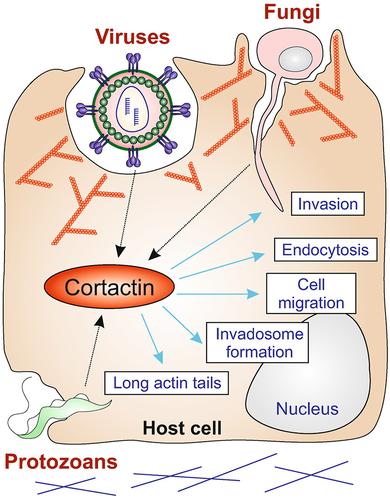当前位置:
X-MOL 学术
›
Mol. Microbiol.
›
论文详情
Our official English website, www.x-mol.net, welcomes your
feedback! (Note: you will need to create a separate account there.)
Cortactin: A major cellular target of viral, protozoal, and fungal pathogens
Molecular Microbiology ( IF 2.6 ) Pub Date : 2024-06-13 , DOI: 10.1111/mmi.15284 Irshad Sharafutdinov 1 , Barbara Friedrich 1 , Klemens Rottner 2, 3 , Steffen Backert 1 , Nicole Tegtmeyer 1
Molecular Microbiology ( IF 2.6 ) Pub Date : 2024-06-13 , DOI: 10.1111/mmi.15284 Irshad Sharafutdinov 1 , Barbara Friedrich 1 , Klemens Rottner 2, 3 , Steffen Backert 1 , Nicole Tegtmeyer 1
Affiliation

|
Many viral, protozoal, and fungal pathogens represent major human and animal health problems due to their great potential of causing infectious diseases. Research on these pathogens has contributed substantially to our current understanding of both microbial virulence determinants and host key factors during infection. Countless studies have also shed light on the molecular mechanisms of host–pathogen interactions that are employed by these microbes. For example, actin cytoskeletal dynamics play critical roles in effective adhesion, host cell entry, and intracellular movements of intruding pathogens. Cortactin is an eminent host cell protein that stimulates actin polymerization and signal transduction, and recently emerged as fundamental player during host–pathogen crosstalk. Here we review the important role of cortactin as major target for various prominent viral, protozoal and fungal pathogens in humans, and its role in human disease development and cancer progression. Most if not all of these important classes of pathogens have been reported to hijack cortactin during infection through mediating up- or downregulation of cortactin mRNA and protein expression as well as signaling. In particular, pathogen-induced changes in tyrosine and serine phosphorylation status of cortactin at its major phospho-sites (Y-421, Y-470, Y-486, S-113, S-298, S-405, and S-418) are addressed. As has been reported for various Gram-negative and Gram-positive bacteria, many pathogenic viruses, protozoa, and fungi also control these regulatory phospho-sites, for example, by activating kinases such as Src, PAK, ERK1/2, and PKD, which are known to phosphorylate cortactin. In addition, the recruitment of cortactin and its interaction partners, like the Arp2/3 complex and F-actin, to the contact sites between pathogens and host cells is highlighted, as this plays an important role in the infection process and internalization of several pathogens. However, there are also other ways in which the pathogens can exploit the function of cortactin for their needs, as the cortactin-mediated regulation of cellular processes is complex and involves numerous different interaction partners. Here, the current state of knowledge is summarized.
中文翻译:

Cortactin:病毒、原生动物和真菌病原体的主要细胞靶标
许多病毒、原虫和真菌病原体由于具有引起传染病的巨大潜力而成为人类和动物的主要健康问题。对这些病原体的研究极大地促进了我们目前对感染过程中微生物毒力决定因素和宿主关键因素的理解。无数的研究也揭示了这些微生物所利用的宿主与病原体相互作用的分子机制。例如,肌动蛋白细胞骨架动力学在入侵病原体的有效粘附、宿主细胞进入和细胞内运动中发挥着关键作用。 Cortactin 是一种重要的宿主细胞蛋白,可刺激肌动蛋白聚合和信号转导,最近成为宿主与病原体相互作用的基本参与者。在这里,我们回顾了 cortactin 作为人类各种主要病毒、原生动物和真菌病原体的主要靶标的重要作用,及其在人类疾病发展和癌症进展中的作用。据报道,大多数(如果不是全部)这些重要的病原体类别在感染过程中通过介导 Cortactin mRNA 和蛋白质表达以及信号传导的上调或下调来劫持 Cortactin。特别是病原体诱导的皮质蛋白主要磷酸位点(Y-421、Y-470、Y-486、S-113、S-298、S-405 和 S-418)酪氨酸和丝氨酸磷酸化状态的变化)已解决。正如对各种革兰氏阴性和革兰氏阳性细菌的报道,许多病原性病毒、原生动物和真菌也控制这些调节磷酸位点,例如,通过激活激酶,如 Src、PAK、ERK1/2 和 PKD,已知其磷酸化皮质蛋白。 此外,还强调了 Cortactin 及其相互作用伙伴(如 Arp2/3 复合物和 F-肌动蛋白)招募到病原体和宿主细胞之间的接触位点,因为这在几种病原体的感染过程和内化中发挥着重要作用。然而,病原体还可以通过其他方式利用 Cortactin 的功能来满足其需求,因为 Cortactin 介导的细胞过程调节很复杂,并且涉及许多不同的相互作用伙伴。在此,对当前的知识状况进行了总结。
更新日期:2024-06-13
中文翻译:

Cortactin:病毒、原生动物和真菌病原体的主要细胞靶标
许多病毒、原虫和真菌病原体由于具有引起传染病的巨大潜力而成为人类和动物的主要健康问题。对这些病原体的研究极大地促进了我们目前对感染过程中微生物毒力决定因素和宿主关键因素的理解。无数的研究也揭示了这些微生物所利用的宿主与病原体相互作用的分子机制。例如,肌动蛋白细胞骨架动力学在入侵病原体的有效粘附、宿主细胞进入和细胞内运动中发挥着关键作用。 Cortactin 是一种重要的宿主细胞蛋白,可刺激肌动蛋白聚合和信号转导,最近成为宿主与病原体相互作用的基本参与者。在这里,我们回顾了 cortactin 作为人类各种主要病毒、原生动物和真菌病原体的主要靶标的重要作用,及其在人类疾病发展和癌症进展中的作用。据报道,大多数(如果不是全部)这些重要的病原体类别在感染过程中通过介导 Cortactin mRNA 和蛋白质表达以及信号传导的上调或下调来劫持 Cortactin。特别是病原体诱导的皮质蛋白主要磷酸位点(Y-421、Y-470、Y-486、S-113、S-298、S-405 和 S-418)酪氨酸和丝氨酸磷酸化状态的变化)已解决。正如对各种革兰氏阴性和革兰氏阳性细菌的报道,许多病原性病毒、原生动物和真菌也控制这些调节磷酸位点,例如,通过激活激酶,如 Src、PAK、ERK1/2 和 PKD,已知其磷酸化皮质蛋白。 此外,还强调了 Cortactin 及其相互作用伙伴(如 Arp2/3 复合物和 F-肌动蛋白)招募到病原体和宿主细胞之间的接触位点,因为这在几种病原体的感染过程和内化中发挥着重要作用。然而,病原体还可以通过其他方式利用 Cortactin 的功能来满足其需求,因为 Cortactin 介导的细胞过程调节很复杂,并且涉及许多不同的相互作用伙伴。在此,对当前的知识状况进行了总结。






























 京公网安备 11010802027423号
京公网安备 11010802027423号